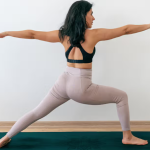In this new monthly series on yoga and parenting, Poppy Pickles explores how being a parent affects our yoga and vice versa. In this blog, Poppy explores how our children’s often irritating behaviour can actually give us a new, helpful perspective on our yoga practice.
Most of us mothers are stuck in the role of ‘bad cop’. In my house I am the one who switches the screens off, who says no to the extra biscuit, who says, ‘Right, it’s time for bed.’ And so on. I am the harbinger of moderation and order.
The role of mother demands it really. I know plenty of happy-go-lucky girls that swore that being a parent wouldn’t change them, and needless to say, post-offspring, they are as hopelessly routine-bound as every other mother before them. It’s part of the inherited protection we offer our children – a consistent and ordered universe that they can feel safe and secure in.
But it is all too easy to allow ourselves to be constrained by this persona. Children, while (let’s be honest) being irritating quite a lot of the time, are actually engaging with life in a much fresher and more spontaneous way than many of us. If we examine what annoys us the most about our children, it’s surprising that actually, we can learn a lot from their behaviour!
Being Present
One of the frustrating aspects of child-rearing is the constant repetition of instructions. ‘Go upstairs and get washed’ being an example of a phrase that can be repeated up to fifteen times on any given school morning. The reason for this is because children learn to zone out anything that doesn’t affect them immediately. They have learnt that if they say, ‘In a minute..’ or, ‘I am!’ (they’re not), they can happily carry on with whatever they’re doing until the very last second.
By the time we get to be adults, we’re not very good at zoning out. During yoga practice it’s very common to drift off into a little worry about whether we left the washing in the machine, or whether you remembered to send a birthday card and so on. It’s even harder to zone out during the final pose of the class, shavasana. At this point, our physical bodies are completely still, in contrast to the constant twitching of the mind. This is why B. K. S. Iyengar states that shavasana ‘is the most difficult of yogic asanas to perfect.’
We need to learn from our children: we need to zone out our dictatorial ‘list-brain’, which is busy yelling instructions at us, by focusing on the task in hand. By fobbing it off, until it gives up on us and goes away, leaving us to finally be still, and be.
Being Fearless
Our children often give us cause to silently offer up a prayer as we watch them hurl themselves off high things, clamber up rocks, hang off railings. They haven’t yet learnt to become precious about their bodies and falling over and picking themselves up again is a daily occurrence and not a traumatic occasional event.
During our yoga practice we’re often afraid to fall, afraid to put our bodies upside down, worried that we’ll break, hurt ourselves or look stupid.
Instead, we can learn from our children. Go upside down, even if it’s only for a second. That split second will give you a different perspective. Try kicking up into a handstand against the wall. If you don’t quite get up there, you’ve kicked past your fear, and there’s always tomorrow to give it another go.
In the balancing poses, we tense our bodies against the possibility of falling, but if we soften, release our bodies from fear, and stretch into the balance, we might just find that we can fly instead of fall.
Having A Laugh
My kids have this habit of going totally berzerk after tea. Before tea, they drift about moaning and crying, then, once they’ve had a re-fuelling session, their energy levels sharply soar and they bounce about like two little tigers, shrieking and causing mayhem.
Yoga can get quite serious. As practitioners, we take it seriously, and work hard, concentrate, and focus on getting it right. But sometimes, it can help just to be a bit silly.
Laughter is of course, another (relatively new) form of yoga called ‘hasya yoga‘. It began in India and is based on the principal that your body doesn’t know the difference between fake and genuine laughter. By combining deep yogic breathing and playful laughter exercises, the body can reap the psychological and physiological benefits of laughter.
Try doing a ‘fun’ yoga practice with your children (or friends, willing to give it a go) where the goal is to laugh as much as possible, instead of trying to get the yoga as perfect as possible. Maintaining eye contact with everyone while doing the poses, and connecting with your sense of child-like fun will refresh your yoga and release health-boosting endorphins.
Being Looked After
Children have this incredible ability to take. They will keep taking as long as you are willing to keep giving. The other morning I found myself crouched down on the floor doing up my 11 year old son’s shoelaces, while he patted my head gratefully. He’s perfectly capable of doing them himself, but it takes him ages and he wasn’t going to object to me doing them for him.
As parents we naturally want to keep doing things for our children long after we should have stopped. On the other hand, speaking personally here (and I don’t think I’m unique), I’m not very good at letting other people do things for me. I’d rather be in control and do everything myself, MY WAY.
During a yoga class, or even in a home practice, part of the practice is that we have to let go of that control.
It is also really easy to forget that yoga is also there to look after us. Instead of always powering through your practice, working up a sweat, it is equally important to incorporate a restorative sequence. By putting our bodies into recuperative poses, such as supta baddha konasana, we are giving it permission to let go and let the yoga work its magic, without our mental interference. The poses will restore our physical and mental balance so that we don’t have to, all we have to do is not get in the way.













